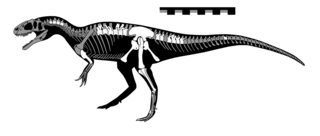
Gasosaurus is a genus of tetanuran theropod that lived approximately 171.6 to 161.2 million years ago during the middle of the Jurassic Period. The name "Gasosaurus" is derived from the English "gasoline" and the Greek σαῦρος. Only one species is currently recognised, G. constructus, from which the specific name honours the gasoline company that found the Dashanpu fossil quarry in Sichuan Province, China, now named as the Lower Shaximiao Formation.

Yangchuanosaurus is an extinct genus of metriacanthosaurid theropod dinosaur that lived in China from the Middle Jurassic to Early Cretaceous periods, and was similar in size and appearance to its North American and European relative, Allosaurus. Yangchuanosaurus hails from the Upper Shaximiao Formation and Suining Formation and was the largest predator in a landscape that included the sauropods Mamenchisaurus and Omeisaurus and the stegosaurs Chialingosaurus, Tuojiangosaurus and Chungkingosaurus. This theropod was named after the area in which was discovered, Yongchuan, in China.

Abrosaurus is a genus of macronarian sauropod dinosaur from the Middle Jurassic Period of what is now Asia, one of many dinosaurs found at the Dashanpu Quarry in the Sichuan Province of China. Like most sauropods, Abrosaurus was a quadrupedal herbivore but it was rather small for a sauropod, not much more than 30 feet (9.1 m) long. Its head was boxy and topped with a tall bony arch containing the nostrils.
Apatodon is a dubious genus of dinosaur that may have been a theropod. The type, and only species, A. mirus, was named in 1877 by Othniel Charles Marsh. It was found in the Late Jurassic-aged Morrison Formation of Colorado.
Xiaosaurus, is a genus of small herbivorous dinosaur from the middle Jurassic, approximately 169 to 163.5 mya. Xiaosaurus lived in what is now the Sichuan Basin of China.

Yandusaurus is a genus of herbivorous basal neornithischian dinosaur from the Bathonian age of China.
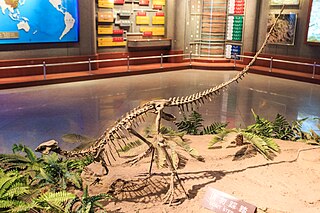
Agilisaurus is a genus of ornithischian dinosaur from the Middle Jurassic Period of what is now eastern Asia. It was about 3.5–4 ft long, 2 ft in height and 40 kg in weight.

Shunosaurus, meaning "Lizard from Sichuan", is a genus of sauropod dinosaur from Late Jurassic (Oxfordian) beds in Sichuan Province in China, from 161 to 157 Million years ago. The name derives from "Shu", an ancient name for the Sichuan province.
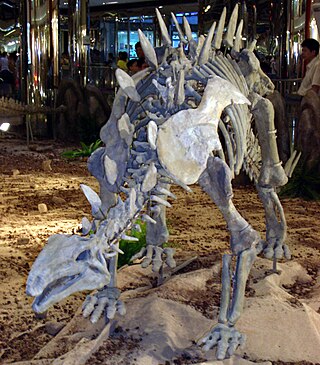
Huayangosaurus is a genus of stegosaurian dinosaur from the Middle Jurassic of China. The name derives from "Huayang" (華陽), an alternate name for Sichuan, and "saurus", meaning "lizard". It lived during the Bathonian to Callovian stages, around 165 million years ago, some 20 million years before its famous relative, Stegosaurus appeared in North America. At only approximately 4 metres (13 ft) long, it was also much smaller than its famous cousin. Found in the Lower Shaximiao Formation, Huayangosaurus shared the local Middle Jurassic landscape with the sauropods Shunosaurus, Datousaurus, Omeisaurus and Protognathosaurus, the ornithopod Xiaosaurus and the carnivorous Gasosaurus.
Zizhongosaurus is a genus of basal herbivorous sauropod dinosaur which lived in the Early Jurassic (Toarcian) Period of China. It was a large-bodied herbivore characterized by a long neck.
Zigongosaurus is a genus of sauropod dinosaur from the Middle Jurassic-Late Jurassic-age Shaximiao Formation of Zigong, Sichuan, China. Because of incomplete knowledge of Jurassic Chinese sauropods, it has been hard to interpret, with some sources assigning it to Omeisaurus, some to Mamenchisaurus, and some to its own genus.
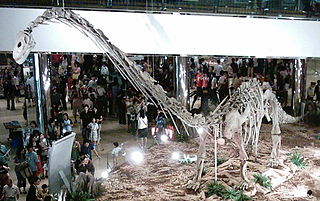
Omeisaurus is a genus of sauropod dinosaur from the Middle Jurassic Period of what is now China. Its name comes from Mount Emei, where it was discovered in the lower Shaximiao Formation of Sichuan Province.

Datousaurus was a dinosaur from the Middle Jurassic. It was a sauropod collected from the Lower Shaximiao Formation in Dashanpu, Zigong Sichuan province, China. It shared the local Middle Jurassic landscape with other sauropods such as Shunosaurus, Omeisaurus, Protognathosaurus, the ornithopod Xiaosaurus, the early stegosaur Huayangosaurus as well as the carnivorous Gasosaurus.
Bashunosaurus is a genus of potentially macronarian sauropod dinosaur from the Middle Jurassic Shaximiao Formation of Kaijiang, China. The type and only species is Bashunosaurus kaijiangensis.

Szechuanosaurus is an extinct genus of carnivorous theropod dinosaur from the Late Jurassic. Fossils referred to the genus have been found in China, Asia in the Oxfordian-?Tithonian. Its type species is based on several undiagnostic teeth from the Kuangyuan Series. Additional possible specimens of Szechuanosaurus were also reported from the Kalaza Formation, also located in China.

Hexinlusaurus is a genus of basal ornithischian dinosaur from the Middle Jurassic of China.
Dashanpusaurus is an extinct genus of sauropod dinosaur that lived during the middle of the Jurassic period. The dinosaur was described in 2005 by Peng Guangzhao, Ye Yong, Gao Yuhui, Shu Chunkang, and Jiang Shan. Its type and only species is Dashanpusaurus dongi, named in honor of the paleontologist Dong Zhiming.

The Shaximiao Formation is a Middle to Late Jurassic aged geological formation in Sichuan, China, most notable for the wealth of dinosaurs fossils that have been excavated from its strata. The Shaximiao Formation is exposed in and around the small township of Dashanpu, situated seven kilometres north-east from Sichuan's third largest city, Zigong, in the Da'an District.
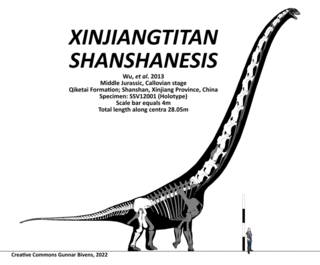
Xinjiangtitan is an extinct genus of mamenchisaurid sauropod that lived during the Middle Jurassic of what is now Xinjiang, northwestern China. Its type and only species is Xinjiangtitan shanshanesis, known from a single incomplete skeleton recovered from the Qiketai Formation. The holotype preserves one of the most complete vertebral columns of any sauropod found in Asia, and has the longest complete neck known for any animal.























